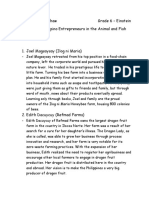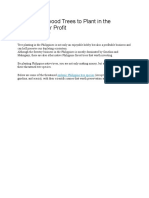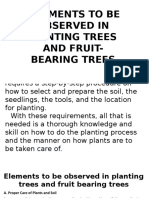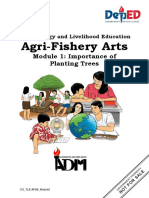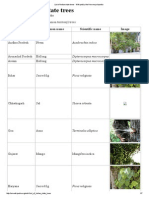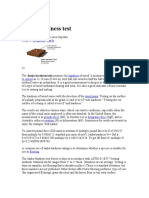Professional Documents
Culture Documents
Non Bearing Fruit Trees
Non Bearing Fruit Trees
Uploaded by
Lei Koyou100%(1)100% found this document useful (1 vote)
18K views5 pagesThe document describes several trees native to the Philippines, including:
1) The balete tree, also known as strangler figs, which begin as epiphytes on other trees and eventually kill the host tree by encircling and suffocating it with roots.
2) Narra, the national tree of the Philippines, which is a large deciduous tree with yellow flowers and winged pods, widely planted for shade and timber.
3) Yakal, a medium to large tree endemic to the Philippines with hard, dark brownish-yellow wood.
Original Description:
Original Title
non bearing fruit trees
Copyright
© © All Rights Reserved
Available Formats
PDF, TXT or read online from Scribd
Share this document
Did you find this document useful?
Is this content inappropriate?
Report this DocumentThe document describes several trees native to the Philippines, including:
1) The balete tree, also known as strangler figs, which begin as epiphytes on other trees and eventually kill the host tree by encircling and suffocating it with roots.
2) Narra, the national tree of the Philippines, which is a large deciduous tree with yellow flowers and winged pods, widely planted for shade and timber.
3) Yakal, a medium to large tree endemic to the Philippines with hard, dark brownish-yellow wood.
Copyright:
© All Rights Reserved
Available Formats
Download as PDF, TXT or read online from Scribd
Download as pdf or txt
100%(1)100% found this document useful (1 vote)
18K views5 pagesNon Bearing Fruit Trees
Non Bearing Fruit Trees
Uploaded by
Lei KoyouThe document describes several trees native to the Philippines, including:
1) The balete tree, also known as strangler figs, which begin as epiphytes on other trees and eventually kill the host tree by encircling and suffocating it with roots.
2) Narra, the national tree of the Philippines, which is a large deciduous tree with yellow flowers and winged pods, widely planted for shade and timber.
3) Yakal, a medium to large tree endemic to the Philippines with hard, dark brownish-yellow wood.
Copyright:
© All Rights Reserved
Available Formats
Download as PDF, TXT or read online from Scribd
Download as pdf or txt
You are on page 1of 5
T. L. E.
/ Agricultural Arts
NON-BEARING FRUIT TREES
ACACIA
Albizia saman (Jacq.) Merr.
RAIN TREE
Acacia is a large umbraculiform tree growing to a height of 20 to
25 meters. Bark is rough and furrowed. Branches are
widespread. Leaves are evenly bipinnate and hairy underneath.
Pinnae are 8 to 12 and 15 centimeters long or less. Leaflets are
12 to 16 in the upper pinnae, 6 to 10 in the lower ones,
decreasing in size downward, hairy beneath, with the mid-nerve
diagonal, and oblong-rhomboid, 1.5 to 4 centimeters long.
Flowers are pink, borne in dense, peduncled, axillary, solitary,
fascicled heads. Fruits are pods, straight, somewhat fleshy,
indehiscent, 15 to 20 centimeters long, 2 centimeters wide, with a pulpy sweet mesocarp.
BALETE
Ficus stipulosa
Balete tree (also known as balite or baliti) are several species
of the trees in the Philippines from the genus Ficus that are
broadly referred to as balete in the local language. A number
of these are known as strangler figs wherein they start upon
other trees, later entrapping them entirely and finally killing
the host tree. Also called hemiepiphytes, initially, they start
as epiphytes or air plants and grow several hanging roots
that eventually touch the ground and from then on, encircling
and suffocating the host tree.
NARRA
Pterocarpus indicus Leguminosae
Large deciduous tree up to 40 m tall. Compound leaves to 30 cm
long with 5 to 11 leaflets. The flowers are yellow, fragrant and to 1.5
cm long. The pods are surrounded by a broad wing and contain one
seed. Widely planted in the Philippines for shade and for its valuable
timber. Indigenous to South Asia and the Pacific. It grows fast and
resists strong winds. There are two subspecies: the smooth narra
(P.indicus indicus) has smooth pods, while the prickly narra (P.
indicus echinatus) has spiny pods. This beloved tree is the national
tree of the Philippines.
JOHN PRINCE JURIZ M. ALCANTARA
Grade VI - Altair
APITONG
Dipterocarpus grandiflorus (Blanco) Blanco
Apitong is a species of flowering plant in the
Dipterocarpaceae family. It is an endangered medium
hardwood tree in South-East Asia and India. Its wood is used
to produce good quality charcoal, paper pulp, and timber
sold under the Keruing designation. Its gum is used locally
as a waterproofing varnish. The tree itself is very
useful for nitrogen fixing, erosion control, soil improvement,
and watershed regulation.
BALETE
Ficus stipulosa
Balete tree (also known as balite or baliti)
are several species of the trees in the
Philippines from the genus Ficus that are
broadly referred to as balete in the local
language. A number of these are known
as strangler figs wherein they start upon
other trees, later entrapping them
entirely and finally killing the host tree.
Also called hemiepiphytes, initially, they
start as epiphytes or air plants and grow
several hanging roots that eventually
touch the ground and from then on,
encircling and suffocating the host tree.
IPIL IPIL
Leucaena leucocephala
Leguminosae
Small to medium-sized tree with doubly
compound leaves to 25 cm long. Flowers are
white, in round clusters. Pods are numerous,
flat and shiny brown. A native of tropical
America, it is now thoroughly naturalized
thoughout the tropics including the
Philippines. Usually a bush or small tree up to
6 m high, giant strains to 15 m and more have
been introduced from Hawaii in the 1970s. It
is extensively planted in the country as a
reforestation species to control soil erosion.
Highly resistant to high temperature, shade,
drought, salinity, pests and disease.
MOLAVE
Vitex parviflora
Verbenaceae
Molave is a medium size tree which
grows to 15 meters, The leaves are
compound with 3 leaflets. The flowers
are bluish, numerous, in clusters at
the end of small branches. The fruits
are round, dark blue, 5 mm in size.
Molave is well known for its strong,
rough and durable wood. It used to be
widespread in the Philippines, but is
now becoming rare in the wild due to
excessive logging. Occasionally planted
along roadsides and parks.
MAHOGANY
Swietenia macrophylla
Meliaceae
Large tree growing to 40 m. The leaves are
compound, with 3 to 6 pairs of leaflets. The
flowers are small and greenish-yellow. The
fruit is a brown woody capsule to 20 cm long.
Its wood is valuable for furniture and house
furnishing. It is a native of Central America
but is widely planted along roadsides and as
a reforestation species in the Philippines.
NARRA
Pterocarpus indicus
Leguminosae
Large deciduous tree up to 40 m
tall. Compound leaves to 30 cm long
with 5 to 11 leaflets. The flowers are
yellow, fragrant and to 1.5 cm long.
The pods are surrounded by a broad
wing and contain one seed. Widely
planted in the Philippines for shade
and for its valuable timber.
Indigenous to South Asia and the
Pacific. It grows fast and resists
strong winds. There are two
subspecies: the smooth narra
(P.indicus indicus) has smooth
pods, while the prickly narra (P. indicus echinatus) has spiny pods. This beloved tree
is the national tree of the Philippines.
YAKAL
Shorea astylosa
It is a species of plant in the family
Dipterocarpaceae. It is endemic to the
Philippines, which is known as yakal in
Filipino language.Yakal is a medium to
large tree about 25 to 30 meters tall. Its
wood is hard and dark brownish-yellow.
Branchlets are rather slender, blackish,
and slightly hairy. Leaves are coriaceous,
ovate to lanceolate or oblong-lanceolate or
apex acuminate; the base is rounded to
cuneate, glabrous above, and slightly
hairy underneath.
You might also like
- Philippine Trees 101: Trees With Description PDFDocument10 pagesPhilippine Trees 101: Trees With Description PDFDerrick Yson (Mangga Han)100% (2)
- Philippine Hardwoods and SoftwoodsDocument12 pagesPhilippine Hardwoods and SoftwoodsBryle Peter Dc. SampagaNoch keine Bewertungen
- Parts of Bahay KuboDocument3 pagesParts of Bahay KuboAustria Karla0% (1)
- Successful Entrepreneurs in Animal and Fish RaisingDocument2 pagesSuccessful Entrepreneurs in Animal and Fish RaisingAnonymous 86zpM9yjPR77% (52)
- All Successful Filipino Entrepreneurs in The Animal and Fish Raising IndustryDocument6 pagesAll Successful Filipino Entrepreneurs in The Animal and Fish Raising IndustryMarie Anhaw67% (30)
- Native Plants of The PhilippinesDocument4 pagesNative Plants of The PhilippinesMark Angielo TrillanaNoch keine Bewertungen
- Annual Growth Rings - Tree Knowledge - Booklet - Forest Academy - DomtarDocument6 pagesAnnual Growth Rings - Tree Knowledge - Booklet - Forest Academy - DomtarGek CagatanNoch keine Bewertungen
- Endangered Animals in The PhilippinesDocument3 pagesEndangered Animals in The PhilippinesRossking Garcia100% (1)
- AGTA or AETA ETHIC GROUPDocument2 pagesAGTA or AETA ETHIC GROUPHeidi PARAGUYANoch keine Bewertungen
- List of Species in FBS 21 - Taxonomy of Forest PlantsDocument29 pagesList of Species in FBS 21 - Taxonomy of Forest PlantsCapale MC100% (1)
- Overview of Palay CheckDocument38 pagesOverview of Palay CheckFroy100% (1)
- Pasture and Forage Collection and IdentificationDocument21 pagesPasture and Forage Collection and IdentificationGaryong Vlog100% (1)
- Endemic Plants & Animals in The PhilippinesDocument8 pagesEndemic Plants & Animals in The Philippinespatricia de roxas67% (3)
- Succesful Orchard Owners - PPTX Version 1Document18 pagesSuccesful Orchard Owners - PPTX Version 1Arnel Copina25% (4)
- Endemic and Endangered Plants and AnimalDocument4 pagesEndemic and Endangered Plants and AnimalIssa 23Noch keine Bewertungen
- Album On Flowers Ornamental PlantsDocument40 pagesAlbum On Flowers Ornamental PlantsKashfee Habib80% (5)
- TOS TLE 6 DepedDocument2 pagesTOS TLE 6 DepedNota Belz80% (15)
- RM BitchDocument12 pagesRM Bitchjaimelton83% (6)
- Agriculture 6 - W4Document17 pagesAgriculture 6 - W4Mhae_DarksnowNoch keine Bewertungen
- Sloping Agricultural Land Technology - SALT 1Document25 pagesSloping Agricultural Land Technology - SALT 1cdwsg254100% (1)
- Specialized Part of PlantsDocument6 pagesSpecialized Part of Plants9lake100% (10)
- Common Farm EquipmentDocument5 pagesCommon Farm EquipmentZab100% (4)
- Tle Agri Grade 6 Module 3Document9 pagesTle Agri Grade 6 Module 3Maribel A. Bustillo100% (5)
- LanzonesDocument29 pagesLanzonesrichardmaravillas100% (6)
- Compendium of Notes in Grade 6 Tle - AgricultureDocument53 pagesCompendium of Notes in Grade 6 Tle - AgricultureC VDNoch keine Bewertungen
- Bamboo Research in The PhilippinesDocument11 pagesBamboo Research in The PhilippinesCleo BuendichoNoch keine Bewertungen
- Career Decision Making TheoryDocument9 pagesCareer Decision Making TheoryLei Koyou100% (3)
- BNS Form No 3ADocument1 pageBNS Form No 3ALei Koyou100% (1)
- Trees Used For Paper Making PDFDocument3 pagesTrees Used For Paper Making PDFVilicchNoch keine Bewertungen
- Wood Book SampleDocument31 pagesWood Book SampleStefan Neagu100% (1)
- Cedomil Silic Atlas Drveca - I - GrmljaDocument188 pagesCedomil Silic Atlas Drveca - I - GrmljaTrif Trifunovic100% (1)
- List of Flowers in The PhilippinesDocument7 pagesList of Flowers in The PhilippinesRhea Jean Bereso100% (1)
- List of Fruit Bearing Trees Found in The PhilippinesDocument1 pageList of Fruit Bearing Trees Found in The Philippinesvada_so77% (13)
- Philippine WeedsDocument5 pagesPhilippine WeedsVlyn OreNoch keine Bewertungen
- Endangered Tree Species in The PhilippinesDocument40 pagesEndangered Tree Species in The PhilippinesKaye Carrillo DuranNoch keine Bewertungen
- Crop Science DIRECTION: Encircle The Letter of The Best Answer From The Choices GivenDocument14 pagesCrop Science DIRECTION: Encircle The Letter of The Best Answer From The Choices GivenRoh Naldz100% (2)
- Common Insects of Common Crops in The PhilippinesDocument2 pagesCommon Insects of Common Crops in The PhilippinesJESRYL PAULITE100% (1)
- Importance of Planting and Propagating Trees and Fruit-Bearing (Autosaved)Document17 pagesImportance of Planting and Propagating Trees and Fruit-Bearing (Autosaved)Velyn Decio86% (35)
- Top 15 Hardwood Trees To Plant in The Philippines For ProfitDocument6 pagesTop 15 Hardwood Trees To Plant in The Philippines For ProfitAngeline Fran Farquerabao FeliaNoch keine Bewertungen
- Weed AlbumDocument40 pagesWeed Albumreignover100% (3)
- Sources of Fruit Bearing TreesDocument34 pagesSources of Fruit Bearing TreesResa Consigna Magusara100% (6)
- LM EPP 6 AgricultureDocument77 pagesLM EPP 6 AgricultureDan Pacyao Miras83% (109)
- The Indigenous Houses of Cultural Communities Shapes and Colors of The Famous LandmarksDocument13 pagesThe Indigenous Houses of Cultural Communities Shapes and Colors of The Famous LandmarksDen Gan Ma100% (1)
- Successful Orchard Growers PPT by ANA LORENA P. BAUTISTADocument35 pagesSuccessful Orchard Growers PPT by ANA LORENA P. BAUTISTACleje Claud80% (15)
- 10 Successful Animal Raiser - KZDocument7 pages10 Successful Animal Raiser - KZAnonymous JfgyvtWwks63% (27)
- Tree Family & Common NameDocument4 pagesTree Family & Common NameJanine TugononNoch keine Bewertungen
- The Successful Orchard Growers in The CommunityDocument2 pagesThe Successful Orchard Growers in The CommunityHoney Staana80% (5)
- Tupas Business PlanDocument8 pagesTupas Business PlanDarwin AniarNoch keine Bewertungen
- Glossary of Common Terms in Nursery and Plantation TechniquesDocument10 pagesGlossary of Common Terms in Nursery and Plantation TechniquesJelibeth OnsayagNoch keine Bewertungen
- Types of Orchard FarmsDocument13 pagesTypes of Orchard FarmsClej Javier Claud-Candari100% (2)
- Propagating Trees and Fruit TreesDocument4 pagesPropagating Trees and Fruit TreesSonny Matias100% (2)
- Different Tools and Equipment Used in Plant PropagationDocument37 pagesDifferent Tools and Equipment Used in Plant PropagationLloyd MontecalvoNoch keine Bewertungen
- Garden Tools Used in Animal ProductionsDocument5 pagesGarden Tools Used in Animal ProductionsLucille BallaresNoch keine Bewertungen
- SWINE PRODUCTION Review 2010Document124 pagesSWINE PRODUCTION Review 2010Quinnee Vallejos83% (6)
- Hardwood and Softwood in The PhilippinesDocument13 pagesHardwood and Softwood in The PhilippinesCristina ApostolNoch keine Bewertungen
- Scientific Practices in Planting Trees and Fruit TreesDocument1 pageScientific Practices in Planting Trees and Fruit TreesJunabel50% (2)
- Land PreparationDocument2 pagesLand PreparationDiana Daina80% (5)
- Bush Sitao ProductionDocument8 pagesBush Sitao Productionpandaypira100% (1)
- ENDANGERED Plants SPECIES IN THE PHILIPPINESDocument21 pagesENDANGERED Plants SPECIES IN THE PHILIPPINESCharles LealNoch keine Bewertungen
- Review of Related LiteratureDocument15 pagesReview of Related LiteratureJosephine Flores100% (1)
- TLE-TE 6 - Q1 - Mod1 - AgricultureDocument11 pagesTLE-TE 6 - Q1 - Mod1 - AgricultureSACATA NATIONAL HIGH SCHOOL100% (1)
- Elements To Be Observed in Planting TreesDocument18 pagesElements To Be Observed in Planting TreesDolores Dellosa Noga85% (13)
- TLE AFA6 Mod1 Importance of Planting Trees v2Document22 pagesTLE AFA6 Mod1 Importance of Planting Trees v2Vergel Nogal100% (2)
- Chapter 1 and 2 Principles of Crop ProtectionDocument40 pagesChapter 1 and 2 Principles of Crop ProtectionRusia Mae Feniz100% (3)
- List of Fruit Bearing Trees Found in The Philippines PDFDocument1 pageList of Fruit Bearing Trees Found in The Philippines PDFMon Kiego MagnoNoch keine Bewertungen
- Almaciga TreesDocument15 pagesAlmaciga Treeschristinemangahas5Noch keine Bewertungen
- Siniloan Elementary School Siniloan, LagunaDocument6 pagesSiniloan Elementary School Siniloan, LagunaLei KoyouNoch keine Bewertungen
- Stealing Bases (Agawan Base)Document10 pagesStealing Bases (Agawan Base)Lei KoyouNoch keine Bewertungen
- COVID-19 Dental Screening QuestionnaireDocument1 pageCOVID-19 Dental Screening QuestionnaireLei KoyouNoch keine Bewertungen
- F.S. II Project Organically Grown Pechay & MustardDocument3 pagesF.S. II Project Organically Grown Pechay & MustardLei KoyouNoch keine Bewertungen
- SCIENCE 4 Activity SheetsDocument7 pagesSCIENCE 4 Activity SheetsLei Koyou100% (1)
- Drug AbuseDocument23 pagesDrug AbuseLei KoyouNoch keine Bewertungen
- 12 Roman GodsDocument1 page12 Roman GodsLei KoyouNoch keine Bewertungen
- Spelling For Grade 1Document1 pageSpelling For Grade 1Lei KoyouNoch keine Bewertungen
- OPT Plus Form 1. List of Preschoolers With Weight and Height Measurement and Identified Nutritional StatusDocument16 pagesOPT Plus Form 1. List of Preschoolers With Weight and Height Measurement and Identified Nutritional StatusLei Koyou100% (1)
- Barangay Wawa Nutritional Status OPT Jan. 2nd Quarter 3rd Quarter 4th QuarterDocument4 pagesBarangay Wawa Nutritional Status OPT Jan. 2nd Quarter 3rd Quarter 4th QuarterLei KoyouNoch keine Bewertungen
- Clever Rabbit CoverDocument1 pageClever Rabbit CoverLei KoyouNoch keine Bewertungen
- 12 Roman Gods: Zeus/ Jupiter Hades/ Pluto Poseidon/ NeptuneDocument1 page12 Roman Gods: Zeus/ Jupiter Hades/ Pluto Poseidon/ NeptuneLei KoyouNoch keine Bewertungen
- TexasEcologicalSystems Phase3 InterpretiveGuide Appendix1Document86 pagesTexasEcologicalSystems Phase3 InterpretiveGuide Appendix1TPWD_GISNoch keine Bewertungen
- Ficus Microcarpa and Ficus Benjamina Oct 2017 PDFDocument4 pagesFicus Microcarpa and Ficus Benjamina Oct 2017 PDFSallqa PachaNoch keine Bewertungen
- Wood Handbook - Wood As Engineering MaterialDocument470 pagesWood Handbook - Wood As Engineering MaterialMichael Esimu100% (7)
- Physics Scope and DeliminationDocument5 pagesPhysics Scope and DeliminationAsher MananganNoch keine Bewertungen
- List of Indian State TreesDocument7 pagesList of Indian State TreesRasu RawatNoch keine Bewertungen
- Summer Branch DropDocument3 pagesSummer Branch DropThe Globe and MailNoch keine Bewertungen
- The Peach Is Known As A Species of PrunusDocument1 pageThe Peach Is Known As A Species of PrunusAnonymous oV47buBoNoch keine Bewertungen
- SP Joyville GurugramDocument19 pagesSP Joyville GurugramSurendra RealtorNoch keine Bewertungen
- Armillaria List 2008 06 16Document18 pagesArmillaria List 2008 06 16Andrea CussighNoch keine Bewertungen
- Bonsai Today Magazine Cont Ay Magazine Contents Fe - 5a2b72f71723ddfcdce1f15c PDFDocument5 pagesBonsai Today Magazine Cont Ay Magazine Contents Fe - 5a2b72f71723ddfcdce1f15c PDFGiampaolo PastorinoNoch keine Bewertungen
- GILMAN Structural PruningDocument8 pagesGILMAN Structural PruningwdarreNoch keine Bewertungen
- Pennsylvania Department of Conservation and Natural Resources Bureau of ForestryDocument9 pagesPennsylvania Department of Conservation and Natural Resources Bureau of ForestryVenkata Sai MvsNoch keine Bewertungen
- Sr. No. Tree's Name (Common Name) Tree's Name (Scientific Names) QntyDocument4 pagesSr. No. Tree's Name (Common Name) Tree's Name (Scientific Names) QntyShrey PatelNoch keine Bewertungen
- LotDetails 18-19 26328 197017Document28 pagesLotDetails 18-19 26328 197017Don Poul JoseNoch keine Bewertungen
- Identifying Conifer Trees in IowaDocument4 pagesIdentifying Conifer Trees in IowaRJohnson64Noch keine Bewertungen
- Janka Hardness Test: Navigation SearchDocument5 pagesJanka Hardness Test: Navigation SearchSafy SerenityNoch keine Bewertungen
- CPN Letterhead Long With Pricelist February 2014Document2 pagesCPN Letterhead Long With Pricelist February 2014Michelle PacubasNoch keine Bewertungen
- Offer - Agarwood Pieces and KynamDocument5 pagesOffer - Agarwood Pieces and KynamDinh xuan BaNoch keine Bewertungen
- Smith Flooring Product List 2010Document1 pageSmith Flooring Product List 2010JustinNoch keine Bewertungen
- Choosing The Best BirchDocument3 pagesChoosing The Best BirchSGNoch keine Bewertungen
- Geography SbaDocument16 pagesGeography SbaMarissa4550% (2)
- Shade Tolerant Trees, Shrubs, and GroundcoversDocument4 pagesShade Tolerant Trees, Shrubs, and GroundcoversKirk's Lawn CareNoch keine Bewertungen
- Nama Latin Buah BuahanDocument9 pagesNama Latin Buah BuahanMelinda Ade KantariNoch keine Bewertungen
- Paulownia Trees Clon Invitro 112® Planted in València, Spain. Miquel Coll PlantationDocument7 pagesPaulownia Trees Clon Invitro 112® Planted in València, Spain. Miquel Coll PlantationJorge Eduardo Solano SandovalNoch keine Bewertungen
- Pleaching - WikipediaDocument3 pagesPleaching - WikipediaKalabasa BasuraNoch keine Bewertungen




